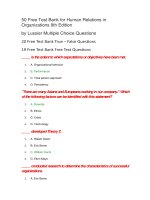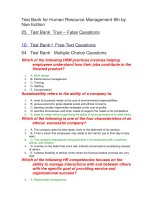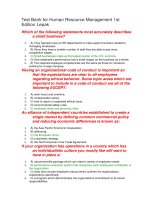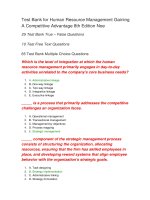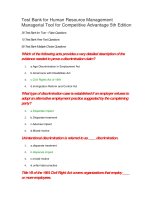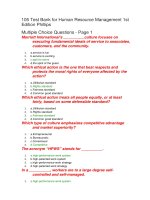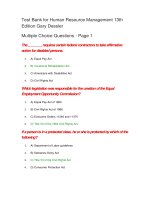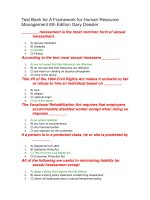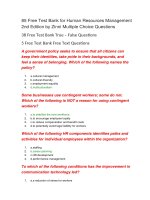89 test bank for human resource management 9th by noe edition
Bạn đang xem bản rút gọn của tài liệu. Xem và tải ngay bản đầy đủ của tài liệu tại đây (116.64 KB, 19 trang )
Test Bank for Human Resource Management 9th by
Noe Edition
25 Test Bank True – False Questions
10 Test Bank f Free Text Questions
54 Test Bank Multiple Choice Questions
Which of the following HRM practices involves helping
employees understand how their jobs contribute to the
finished product?
1.
2.
3.
4.
5.
A. Work design
B. Performance management
C. Training
D. Staffing
E. Compensation
Sustainability refers to the ability of a company to:
1.
2.
3.
4.
5.
A. meet its business needs at the cost of environmental responsibilities.
B. pursue economic goals despite social and ethical concerns.
C. develop socially responsible strategies at the cost of profits.
D. sacrifice its business and other needs to support the needs of its competitors.
E. meet its needs without sacrificing the ability of future generations to meet theirs.
Which of the following is one of the four characteristics of an
ethical, successful company?
1.
2.
A. The company gets the best deals, even to the detriment of its vendors.
B. It has a vision that employees may relate to but cannot use in their day-to-daywork.
3. C. The company emphasizes mutual benefits in its relationship with customers,
clients, and vendors.
4. D. It works on the belief that one's own interest comes before considering interest
of others.
5. E. It allows flexibility of ethical norms when the financial stakes involved are very
high.
Which of the following HR competencies focuses on the
ability to manage interactions with and between others
with the specific goal of providing service and
organizational success?
1.
A. Relationship management
2.
3.
4.
5.
B. HR technical expertise
C. Organizational navigation
D. Ethical practice
E. Business acumen
Which of the following arguments states that companies
develop reputations on favorability as prospective
employers for women and ethnic minorities?
1.
2.
3.
4.
5.
A. System flexibility argument
B. Marketing argument
C. Employee attraction argument
D. Problem-solving argument
E. Creativity argument
Which of the following is true of virtual teams?
1.
2.
3.
4.
5.
A. They are typically situated in the same location.
B. They usually work in the same time zone.
C. They can work well without relying on technology.
D. They do not include partnership with competitors.
E. They allow projects to be worked on 24 hours a day.
Exporting jobs from developed to less developed countries
is known as _____.
1.
2.
3.
4.
5.
A. insourcing
B. offshoring
C. reshoring
D. onshoring
E. homesourcing
Organizations that pursue a _____ strategy pursue the "triple
bottom line" of economic, social, and environmental
benefits.
1.
2.
3.
4.
5.
A. business
B. corporate
C. sustainable
D. communal
E. profit
Jake, the CEO of a company, appraises his managers based
on how well they empower their employees. Which of
the following managers is Jake likely to rate the
highest in this regard?
1.
A. Ben, who gives clear instructions to his subordinates and expects them to
follow the orders exactly as given
2.
B. Melody, who asks her subordinates to always check with her before making any
decisions
3. C. John, who prefers that members of his team always report to him what they do
through the day
4. D. Zara, who assigns responsibility to her subordinates and intervenes only when
there is a need
5. E. Dave, who assigns complete authority to his subordinates and does not offer
any guidance
A company competes for the Malcolm Baldrige National
Quality Award. If it is evaluated based on how senior
executives create and sustain vision, values, and
mission, it is likely that the company is being judged
on the criterion of _____.
1.
2.
3.
4.
5.
A. strategic planning
B. workforce focus
C. customer and market focus
D. operation focus
E. leadership
Which of the following statements is true about the
Sarbanes-Oxley Act of 2002?
1.
2.
3.
4.
5.
A. In case of noncompliance, it limits charges to heavy fines; it does not include
prison terms for executives.
B. Organizations spend millions of dollars each year to comply with regulations
under the Sarbanes-Oxley Act.
C. It imposes no criminal penalty for corporate governing and accounting lapses.
D. Retaliation against whistle-blowers is not included as a violation under the law.
E. It was passed in response to illegal and unethical behavior by employees
toward the management.
Which of following is true of lean thinking?
1.
2.
A. It is a way to do minimal work with highest attention and care for details.
B. It aims to deliver the best customer service while compromising on volume and
quantity.
3. C. It is a way to create quality products and services using maximum resources.
4. D. It aims to do more with less effort, time, space, and equipment.
5. E. It is discouraged by training and quality programs.
Which of the following is true of cloud computing?
1.
2.
3.
A. It allows companies to lease software but not hardware.
B. Employees are not aware of the location of the databases.
C. Company data that is stored on the public cloud can be is accessed by the
public.
4. D. It can be accessed only through computers; other gadgets cannot be used.
5. E. It requires an external system to retrieve data from the cloud.
Which of the following statements is true about Generation
X?
1.
2.
3.
4.
5.
A. It includes people who were born between 1925 and 1945.
B. It grew up much before the personal computer was invented.
C. It values skepticism and informality.
D. It is called the "me" generation.
E. It prefers close supervision and has a lot of patience.
Which of the following arguments states that diversity of
perspectives and less emphasis on conformity to
norms of the past should improve the level of
resourcefulness?
1.
2.
3.
4.
5.
A. System flexibility argument
B. Marketing argument
C. Employee attraction and retention argument
D. Problem-solving argument
E. Creativity argument
According to emerging changes in the employment
relationship, which of the following benefits do
employees typically not expect to be provided by
employers?
1.
2.
3.
4.
5.
A. Flexible work schedules
B. Comfortable working conditions
C. More autonomy
D. Employability
E. Job security
Mentoring relationships are an example of _____ capital.
1.
2.
3.
4.
5.
A. social
B. customer
C. human
D. intellectual
E. financial
Tacit knowledge is an example of _____ capital.
1.
2.
3.
4.
5.
A. social
B. customer
C. human
D. intellectual
E. financial
Which of the following HRM practices involves employees
receiving feedback?
1.
2.
3.
4.
5.
A. Work design
B. Performance management
C. Training
D. Staffing
E. Compensation
Which of the following HRM practices involves employees
participating in peer interviews?
1.
2.
3.
4.
5.
A. Work design
B. Performance management
C. Training
D. Staffing
E. Compensation
Which of the following major dimensions of HRM practices
involves training employees to have the skills needed
to perform their jobs?
1.
2.
3.
4.
5.
A. Vision and mission of human resources
B. Managing the human resource environment
C. Acquiring and preparing human resources
D. Compensating human resources
E. Assessment and development of human resources
Which of the following is a core value of TQM?
1.
2.
3.
4.
5.
A. Methods are designed to meet the needs of external customers and not internal
customers.
B. A few select employees in an organization are given training in quality.
C. Processes are designed such that errors are detected and corrected
immediately after they occur.
D. The company promotes cooperation with vendors and customers to hold down
costs.
E. Managers measure progress with feedback based on qualitative observations.
When companies are trying to meet the shareholders' and
the general public's demands to act more ethically and
environmentally responsible, they are recognizing the
importance of _____.
1.
2.
3.
4.
5.
A. a balanced scorecard approach
B. performance management
C. total quality management
D. social responsibility
E. cultural responsibility
Distribution channels are an example of _____ capital.
1.
2.
3.
4.
5.
A. social
B. customer
C. human
D. intellectual
E. financial
Trade secrets are an example of _____ capital.
1.
2.
3.
4.
5.
A. social
B. customer
C. human
D. intellectual
E. financial
Which of the following is a characteristic of people of the
baby boomer generation?
1.
2.
3.
4.
5.
A. They surrender to establishments.
B. They lack social conscientiousness.
C. They do not conform to rules.
D. They are considered to be workaholics.
E. They focus on maintaining a hierarchy even at the cost of justice.
When considering a balanced scorecard that depicts a
company from a(n) _____ perspective, the critical HR
indicators are employee satisfaction with HR
department services and employee perceptions of the
company as an employer.
1.
2.
3.
4.
5.
A. learning
B. internal
C. financial
D. customer
E. innovation
Which of the following activities is part of the assessment
and development of human resources dimension of
HRM practices?
1.
2.
3.
4.
A. Training employees to have the skills needed to perform their jobs
B. Identifying human resource requirements
C. Ensuring that HRM practices comply with federal, state, and local laws
D. Creating an employment relationship and work environment that benefits the
company
5. E. Creating pay systems as well as providing employees with benefits
Which of the following arguments states that heterogeneity
in decisions potentially produces better decisions
through a wider range of perspectives and critical
analysis?
1.
2.
3.
4.
5.
A. System flexibility argument
B. Marketing argument
C. Employee attraction argument
D. Problem-solving argument
E. Creativity argument.
Which of the following is a prediction about legal issues
regarding employment in the U.S.?
1.
2.
3.
4.
5.
A. The emphasis on eliminating discrimination is likely to end.
B. The focus will turn away from pre-employment tests.
C. There will be more focus on criminal background screening.
D. There are likely to be lesser challenges to race discrimination.
E. There will be less emphasis on discrimination against veterans.
An HR dashboard is a series of indicators that:
1.
2.
3.
4.
5.
A. only HR managers have access to.
B. requires communication via an extranet.
C. allows the public to understand the HR policies of a company.
D. enables workforce analytics and evidence-based HR.
E. helps managers hire new employees based on secondary data.
Which of the following HRM practices involves rewarding
employees based on their team's performance?
1.
2.
3.
4.
5.
A. Work design
B. Performance management
C. Training
D. Staffing
E. Compensation
Which of the following, if true, would support reshoring as a
strategy for a U.S. firm?
1.
2.
3.
4.
5.
A. Decreasing labor costs overseas
B. Increasing wage costs in the United States
C. Increasing public support in the United States for offshoring
D. Increasing transportation costs
E. Decreasing cost of living overseas
In high-performance work systems:
1.
A. previously established boundaries between employees and customers remain
intact.
2.
B. managers and employees work together, while vendors and suppliers work
independently.
3. C. line employees are trained to specialize in individual tasks.
4. D. employees do not communicate directly with suppliers and customers.
5. E. line employees interact frequently with quality experts and engineers.
Which of the following people would be categorized as part
of the external labor market with regards to Phoenix
Inc.?
1.
2.
3.
A. John, who works for Phoenix Inc. as a full-time employee
B. Rachel, who works for Phoenix Inc. and is looking for a new job
C. Pete, who is an employee at a direct competitor of Phoenix and is not looking
for a new job
4. D. Roger, who is unemployed and not looking for employment
5. E. Keith, who works for Jupiter Inc. and is seeking employment elsewhere
Which of the following is true of a balanced scorecard?
1.
2.
3.
A. It indicates the value of a company based on its competitive demands.
B. It depicts a company from the perspective of internal and external customers.
C. It measures a company's performance based on the business strategy adopted
by it.
4. D. It should not be used to link HRM activities and a company's business strategy.
5. E. It guides companies to increase the time spent on new product and service
development.
Which of the following arguments states that companies with
the best reputations for managing diversity will win the
competition for talent?
1.
2.
3.
4.
5.
A. System flexibility argument
B. Marketing argument
C. Employee attraction and retention argument
D. Problem-solving argument
E. Creativity argument.
_____ is a companywide effort to continuously improve the
ways people, machines, and systems accomplish
work.
1.
2.
3.
4.
5.
A. The Six Sigma process
B. Total quality management
C. Quality control
D. The process decision program
E. The activity network
Which of the following dimensions of HRM practices
involves ensuring that HRM practices comply with
federal, state, and local laws?
1.
2.
3.
4.
5.
A. Vision and mission of human resources
B. Managing the human resource environment
C. Acquiring and preparing human resources
D. Compensating human resources
E. Assessment and development of human resources
Which one of the following is true about the Six Sigma
process?
1.
2.
A. It focuses on the end product of employee satisfaction.
B. It terminates once the processes have been brought within the Six Sigma
standards.
3. C. It strives to attain quality through supervision of daily work and not through
training.
4. D. It discourages employees from lean thinking.
5. E. It aims to create a total business focus on serving the customer.
A company whose employees have high engagement is
likely to have _____ when compared to a company with
low employee engagement.
1.
2.
3.
4.
5.
A. lower retention
B. lower empowerment
C. poorer customer service
D. lower productivity
E. lower turnover
Which of the following is a prediction about legal issues in
the workplace in the U.S.?
1.
2.
3.
4.
5.
A. Workplace safety will receive lesser attention.
B. HR professionals will work independently without legal counsel.
C. There will be no penalty for not providing health care coverage.
D. Reporting and inspection requirements will decrease.
E. Health care reform will drive compliance issues.
When an HR professional is evaluated on how well she
embraces inclusion and how effectively she works
with diverse populations, she is being evaluated on
her competency in _____.
1.
2.
3.
A. organizational navigation
B. HR technical expertise and practice
C. global and cultural effectiveness
4.
5.
D. business acumen
E. critical evaluation
Which of the following is a concern caused by Gen-Y
generation employees using social networking tools?
1.
2.
3.
4.
5.
A. Knowledge sharing is suppressed
B. Creating online expert communities
C. Loss of expert knowledge
D. Best practices are not shared
E. Lower productivity
Which of the following acts sets strict rules for businesses
especially for accounting practices that require more
open and consistent disclosure of financial data and
CEOs' assurance that the data is completely accurate?
1.
2.
3.
4.
5.
A. Gramm-Leach-Bliley Act
B. Glass-Steagall Act
C. Sarbanes-Oxley Act
D. Dodd-Frank Act
E. McCarran-Ferguson Act
Which of the following statements is true about the
composition of the U.S. labor force in the next
decade?
1.
2.
A. Immigration will cease to affect the size and diversity of the workforce.
B. The largest proportion of the labor force is expected to be in the age group of
16-24 years.
3. C. The percentage of highly skilled immigrants will continue to remain lower than
the percentage of low skilled immigrants.
4. D. The median age of the labor force will increase to the highest number ever.
5. E. The high cost of health insurance and decrease in health benefits will cause
many employees to quit working.
Which of the following arguments emphasizes that reactions
should be faster and cost less?
1.
2.
3.
4.
5.
A. System flexibility argument
B. Marketing argument
C. Employee attraction and retention argument
D. Problem-solving argument
E. Creativity argument
Which of the following is true of how different generations
view each other?
1.
2.
A. Millennials may think Generation X managers are good delegators.
B. Generation X managers may think that Millennials lack self-confidence.
3.
4.
5.
C. Millennials might believe that baby boomers do not comply with company rules.
D. Traditionalists may believe that Millennials don't have a strong work ethic.
E. Baby boomers may consider Millennials to be technologically illiterate.
When an HR professional is evaluated on how well he
understands organizational metrics and their
relationship to business success, he is being
evaluated on his competency in _____.
1.
2.
3.
4.
5.
A. relationship management
B. organizational navigation
C. business acumen
D. business communication
E. ethical practice
A company competing through sustainability is likely to
_____.
1.
2.
3.
4.
5.
A. place increased value on tangible assets
B. avoid social and environmental responsibilities
C. emphasize more on productivity than on quality
D. adapt badly to changes in the labor force
E. provide high-quality products and services
Which of the following is a characteristic of Millennials?
1.
2.
3.
4.
5.
A. They are not comfortable with using computers and the Internet.
B. They are pessimistic and cynical.
C. They have low levels of self-esteem.
D. They are eager to learn, work, and please.
E. They are not narcissistic.
When a corporate organization competes through
globalization, as opposed to technology, it is likely to
put most of its efforts on _____.
1.
2.
3.
4.
5.
A. social responsibility
B. environmental issues
C. expanding into foreign markets
D. developing HR dashboards
E. integrating technology and social systems
Which competency is an HR personnel said to have if he is
able to act personally and professionally with integrity
and accountability?
1.
2.
3.
A. Critical evaluation
B. Consultation
C. Business acumen
4.
5.
D. Communication
E. Ethical practice
_____ refers to a systematic planned strategic effort by a
company to attract, retain, develop, and motivate
highly skilled employees and managers.
1.
2.
3.
4.
5.
A. Performance appraisal
B. Workforce analytics
C. Talent management
D. Training and development
E. Employee engagement
25 Free Test Bank for Human Resource Management
9th Edition by Noe True - False Questions
Social networking tools can help prevent the loss of expert
knowledge that occurs due to retirement.
1.
2.
True
False
Advances in technology have decreased HRM's role in
providing self-service to employees.
1.
2.
True
False
The balanced scorecard should not be used to link a
company's human resource management activities to
the company's business strategy.
1.
2.
True
False
In exchange for working longer hours without job security,
employees want companies to provide flexible work
schedules and comfortable working conditions.
1.
2.
True
False
High-performance work systems minimize the fit between a
company's social system (employees) and its
technical system.
1.
2.
True
False
An HR dashboard is a series of indicators that are accessible
to both managers and employees.
1.
2.
True
False
HR functions related to benefits administration such as
health plan eligibility status, relocation, and payroll are
usually not outsourced.
1.
2.
True
False
Companies have historically looked at HRM as a means to
contribute to profitability and quality.
1.
2.
True
False
Orientation and skills training are responsibilities of HR
personnel involved in analysis and design of work.
1.
2.
True
False
Applications of the Malcolm Baldrige Award are reviewed by
an independent board of examiners who are selected
from the public sector.
1.
2.
True
False
Intangible assets are equally or more valuable than financial
and physical assets, but they are difficult to duplicate
or imitate.
1.
2.
True
False
When a firm shifts to evidence-based HRM, it should stop
using workforce analytics.
1.
2.
True
False
The Sarbanes-Oxley Act of 2002 imposes criminal penalties
for corporate governing and accounting lapses.
1.
2.
True
False
Evidence-based HR refers to the demonstration that human
resources practices have no impact on the company's
bottom or key stakeholders.
1.
2.
True
False
Projections to the demographics of the U.S. workforce
predict that the average age of the workforce will
decrease.
1.
2.
True
False
When it comes to problem solving, cultural diversity can
provide companies with a competitive advantage.
1.
2.
True
False
The amount of time that the HRM function devotes to
administrative tasks is decreasing, and its role as a
strategic business partner is increasing.
1.
2.
True
False
The three product lines of HR as a business are
administrative services and transactions, business
partner services, and strategic partner roles.
1.
2.
True
False
Measuring employees' performance is a part of the
compensation function of HR.
1.
2.
True
False
In a learning organization, improvements in product or
service quality do not stop when formal training is
completed.
1.
2.
True
False
To be effective, balanced scorecards must be customized by
companies to fit different market situations, products,
and competitive environments.
1.
2.
True
False
A company that adopts total quality management (TQM)
trains only selected employees in quality.
1.
2.
True
False
From a company perspective, it is harder to add part-time
employees than it is to add full-time employees.
1.
2.
True
False
Disabled workers can be a source of competitive advantage.
1.
2.
True
False
Lean thinking emphasizes only on learning new skills to
improve and does not encourage the use of old skills
in new ways.
1.
2.
True
False
v 0 Free Test Bank for Human Resource Management
9th Edition by Noe Free Text Questions
Discuss the competencies, according to the Society for
Human Resource Management, which HR
professionals require to be successful.
Answer Given
Following are the nine competencies HR professionals need to have: Human
resource technical expertise and practice: It is the ability to apply the principles of
human resource management to contribute to the success of a business.
Relationship management: It is the ability to manage interactions with and
between others with the specific goal of providing service and organizational
success. Consultation: It refers to providing guidance to stakeholders such as
employees and leaders seeking expert advice on a variety of circumstances and
situations. Organizational leadership and navigation: It is the ability to direct
initiatives and processes within an organization and gain buy-in from stakeholders.
Communications: It is the ability to effectively exchange and create a free flow of
information with and among various stakeholders at all levels of an organization to
produce meaningful outcomes. Global and cultural effectiveness: It is the ability to
manage human resources both within and across boundaries. Ethical practice: It
includes integration of core values, integrity, and accountability throughout all
organizational and business practices. Critical evaluation: It involves the skills
required to interpret information to determine return on investment and
organizational impact in making recommendations and business decisions.
Business acumen: It is the ability to understand business functions and metrics
within an organization and industry.
Discuss what companies should do to compete in the global
marketplace.
Answer Given
Companies are finding that to survive they must compete in international markets
as well as fend off foreign corporations' attempts to gain ground in the United
States. To meet these challenges, U.S. businesses must develop global markets,
use their practices to improve global competitiveness, and better prepare
employees for global assignments. Every business must be prepared to deal with
the global economy. Global business expansion has been made easier by
technology. The Internet allows data and information to be instantly accessible and
sent around the world. The Internet, e-mail, social networking, and video
conferencing enable business deals to be completed between companies
thousands of miles apart. Globalization is not limited to any particular sector of the
economy, product market, or company size. Businesses around the world are
attempting to increase their competitiveness and value by increasing their global
presence, often through mergers and acquisitions.
What is a human resource information system (HRIS)?
Explain the benefits of using an HRIS.
Answer Given
Companies continue to use human resource information systems to store large
quantities of employee data including personal information, training records, skills,
compensation rates, absence records, and benefits usages and costs. A human
resource information system (HRIS) is a computer system used to acquire, store,
retrieve, and distribute information related to a company's human resources. An
HRIS can support strategic decision making, help a company avoid lawsuits,
provide data for evaluating policies and programs, and support day-to-day HR
decisions. Managers use the system to track employees' vacation and sick days
and to make changes in staffing and pay. Using the HRIS, managers can request
the HRIS system to automatically prepare a personnel report; they no longer have
to contact the HR department to request one.
What is an HR dashboard? Explain a few ways in which it
supports managers and employees.
Answer Given
One of the most important uses of Internet technology is the development of HR
dashboards. An HR dashboard is a series of indicators or metrics that managers
and employees have access to on their company's intranet or human resource
information system. The HR dashboard provides access to important HR metrics
for conducting workforce analytics. HR dashboards are important for determining
the value of HR practices and how they contribute to business goals. As a result,
the use of dashboards is critical for evidence-based HR management. For
example, a company may view building talent as a priority so it adds to its
dashboard of people measures a metric to track how many people move and the
reasons. This allows the form to identify divisions that are developing new talent.
Sophisticated systems such as the HR dashboard can extend management
applications to decision making in areas such as compensation and performance
management. Managers can schedule job interviews or performance appraisals,
guided by the system to provide the necessary information and follow every step
called for by the procedure.
Discuss the balanced scorecard approach of measuring
stakeholder performance.
Answer Given
The balanced scorecard gives managers an indication of the performance of a
company based on the degree to which stakeholder needs are satisfied; it depicts
the company from the perspective of internal and external customers, employees,
and shareholders. The balanced scorecard is important because it brings together
most of the features that a company needs to focus on to be competitive. The
balanced scorecard should be used to (1) link human resource management
activities to the company's business strategy and (2) evaluate the extent to which
the HRM function is helping the company meet its strategic objectives.
Communicating the scorecard to employees gives them a framework that helps
them see the goals and strategies of the company, how these goals and strategies
are measured, and how they influence the critical indicators.
What is meant by empowering and what type of training
must be conducted to make it effective?
Answer Given
Empowering means giving employees responsibility and authority to make
decisions regarding all aspects of product development or customer service.
Employees are then held accountable for products and services; in return, they
share the resulting rewards and losses of the results. For empowerment to be
successful, managers must be trained to link employees to resources within and
outside the company, help employees interact with their fellow employees and
managers throughout the company, and ensure that employees are updated on
important issues and cooperate with each other. Employees must also be trained
to use the Web, e-mail, and other tools for communicating, collecting, and sharing
information.
What are the two challenges that HR managers of today
face? Discuss how the shared service model and the
self-service model help them in overcoming the two
challenges.
Answer Given
The amount of time that the HRM function devotes to administrative tasks is
decreasing, and its roles as a strategic business partner, change agent, and
employee advocate are increasing. HR managers face two important challenges:
shifting their focus from current operations to strategies for the future and
preparing non-HR managers to develop and implement human resource practices.
To ensure that human resources contributes to a company's competitive
advantage, many HR departments are organized based on a shared service
model. The shared service model can help control costs and improve the business
relevance and timeliness of HR practices. A shared service model is a way to
organize the HR function that includes centers of expertise or excellence, service
centers, and business partners. Centers of expertise or excellence include HR
specialists in areas such as staffing or training who provide their services
companywide. Service centers are a central place for administrative and
transactional tasks such as enrolling in training programs or changing benefits that
employees and managers can access online. The availability of the Internet has
decreased the HRM role in maintaining records and providing self-service to
employees. Self-service refers to giving employees online access to information
about HR issues such as training, benefits, compensation, and contracts; enrolling
online in programs and services; and completing online attitude surveys.
Outline the four dimensions of human resource management
practices.
Answer Given
(1) Managing the human resource environment: Managing internal and external
environmental factors allow employees to make the greatest possible contribution
to company productivity and competitiveness; (2) Acquiring and preparing human
resources: It involves determining the number and type of employees needed, a
value that is influenced by customer needs, terminations, promotions, and
retirements. Managers also need to identify current or potential employees to fill
those needs; (3) Assessment and development of human resources: Managers
must ensure employees have the necessary skills to perform current and future
jobs. Work may be redesigned to be performed by teams. Companies need to
create a supportive work environment; (4) Compensating human resources: Pay
and benefits are important incentives to offer employees in exchange for
contributing to productivity, quality, and customer service. They are also used to
reward employees' membership and attract new employees.
What is the purpose of the Malcolm Baldrige Award?
Describe the application and evaluation process, and
list the seven characteristics that companies are
scored for in the examination.
Answer Given
The Baldrige Award, created by public law, is the highest level of national
recognition for quality that a U.S. company can receive. It was established to
promote quality awareness, to recognize quality achievements of U.S. companies,
and to publicize successful quality strategies. To become eligible for the Baldrige,
the company must complete a detailed application with basic information about the
firm as well as an in-depth presentation of how it addresses specific criteria related
to quality improvement. Applications are reviewed by an independent board of
about 400 examiners who come primarily from the private sector. One of the major
benefits of applying for the Baldrige Award is the feedback report from the
examining team noting the company's strengths and areas for improvement. The
categories that are evaluated for scoring are: leadership; measurement, analysis,
and knowledge management; strategic planning; workforce focus; operations
focus; results; and customer focus.
Discuss how managing cultural diversity can provide a
competitive advantage to a firm.
Answer Given
Following are the ways in which managing cultural diversity can provide a
competitive advantage: (1) Cost argument: As organizations become more
diverse, the cost of a poor job in integrating workers will increase. Those who
handle this well will thus create cost advantages over those who do not; (2)
Employee attraction and retention argument: Companies will develop reputations
as prospective employers for women and ethnic minorities. Those with the best
reputations for managing diversity will win the competition for talent. This will be
especially important as the labor pool shrinks and changes composition; (3)
Marketing argument: The insight and cultural sensitivity that diverse employees
bring to the marketing effort help a company enter new markets and develop
products and services for diverse populations; (4) Creativity argument: Diversity of
perspectives and less emphasis on conformity to norms of the past improves the
level of creativity; (5) Problem-solving argument: Heterogeneity in decisions and
problem-solving groups potentially produces better decisions through a wider
range of perspectives and more thorough critical analysis of issues; (6) System
flexibility argument: Diversity brings greater flexibility when reacting to changes in
customer preferences and tastes.
